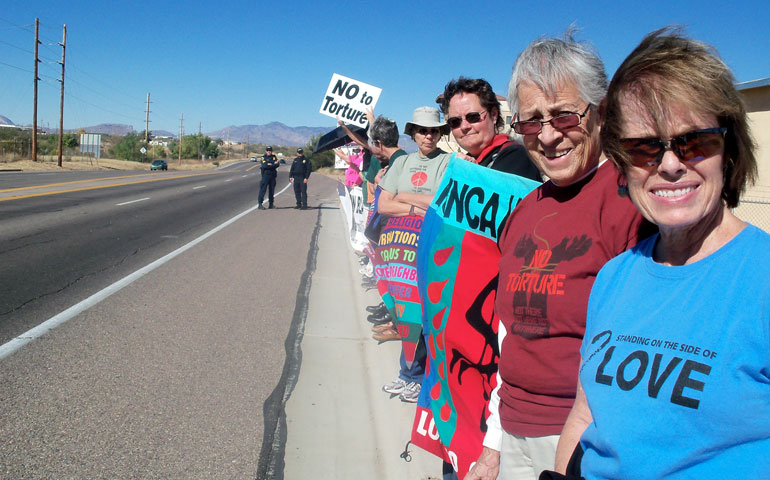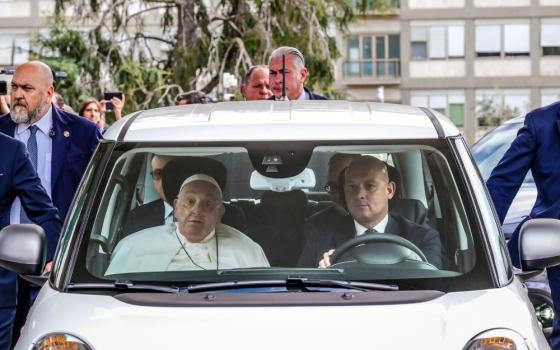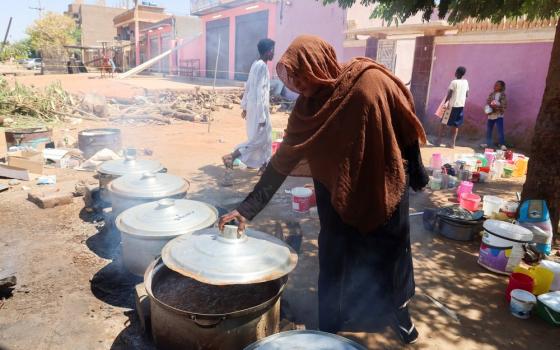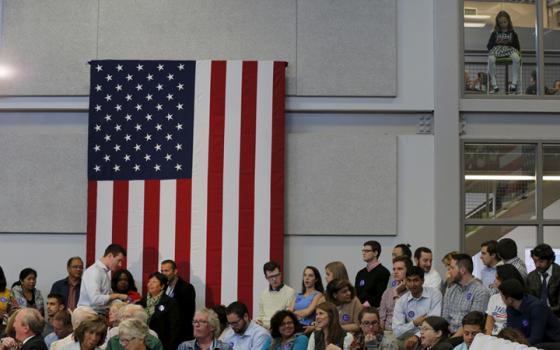
From right: Loretto co-member Maureen Flannagan, Sr. Alicia Ramirez, and co-members Kim Klein and Martha Crawley join a protest against torture on Nov. 14, 2010, at Fort Huachuca, Ariz. (Mary Ann McGivern)
Part 2 of 2. Part 1 of this essay examined the evolution of the committed life.
Suppose someone wants to live a life committed to the Gospel but does not want to live the three traditional vows -- poverty, chastity and obedience -- as they have usually been interpreted. Or maybe only one or two of those vows make sense to that person. Maybe someone wants to pronounce a new vow that speaks to the heart of his or her identity and call. Or maybe she or he wants to develop a new form of committed life without vows. All of these possibilities are already happening -- and evolving.
My friend and spiritual mentor Bill Callahan was a Jesuit with four ecclesial vows (poverty, chastity, obedience and that special vow of obedience to the pope), but he added a fifth: "to live a life of faith dedicated to the works of justice." His life was a documentary on the meaning of that vow.
The Sisters of Mercy have always had four vows, the fourth being "the service of the poor, sick and ignorant." Mother Teresa's Missionaries of Charity take a fourth vow of "service to the poorest of the poor."
A Loretto co-member developed and pronounced three vows that make sense for her: a vow to practice the nonviolence of Jesus, a vow of solidarity with all those not privileged in society, and a vow of ecological sanity in the quest to save our planet.
"New" vows, in other words, are not new.
Let's begin with the three traditional vows, look briefly at their original intent, and re-examine them in the light of the 21st century.
Poverty
In the old days, the vow of poverty often became a vow of dependence. One had to ask the superior for everything from toothpaste to the use of a car. That changed after the Second Vatican Council (1962-65), when vowed religious began to have budgets and spending money.
But dependence was not the purpose of the vow of poverty. This vow was intended to take a person's heart and mind away from the quest for wealth and worldly goods. In practice, it became a vow of sharing, of holding all things in common, a way to throw in one's lot with a group with which one shared ideals.
Many who live the vow of poverty emphasize their commitment to living simply, without a surplus of this world's goods.
So what might a 21st-century vow look like? There are, of course, many possible answers. Someone today might embrace a "vow of sharing" (with other community members or the world at large), or a "vow to live simply" in a world overstuffed with commodities. Or, in an age of climate change, some people might consider a "vow to live ecologically," as one of our Loretto co-members did.
Chastity
The vow of chastity is actually a misnomer. Chastity is a virtue that requires someone to be faithful to his/her state of life or partner. One can be married and chaste at the same time as long as one is faithful to his or her spouse.
In religious life, the vow of chastity is really a vow of celibacy, a vow to live without an exclusive or sexual love relationship with another human being.
The assumption behind this was that a primary love relationship such as marriage would distract from the strongest possible love of God and neighbor. Many theologians challenge this idea, and point to legions of people in committed relationships who are strengthened in their love of God and their ministries by an intimate human relationship. Others would argue that celibacy, for those with that call, can indeed enhance "one-heartedness for God" in the person making the vow.
The basic idea behind celibacy was a quest for expansive love: the devotion of one's heart and mind primarily to God and to the people in one's ministry, the members of one's community and/or the world at large. So what might a vow in this tradition look like in the 21st century?
Those in committed relationships, and even those who are not, might choose to vow "fidelity in loving relationships." For both, this would be a vow of faithfulness to God. For one person this might mean a life of celibacy; for another, a vow of fidelity in an already vowed relationship.
Someone could promise to live a life with an "expansive love of humanity," sharing with those in need and rejecting the traditional human divisions of race, ethnicity, class, gender and/or sexual orientation. This is similar to the "vow of solidarity" one of our Loretto co-members has taken, or it could be called a "vow to live compassionately."
And since love certainly calls for nonviolence, a "vow to live nonviolently" could be a part of such a commitment.
In practice, such evolving vows would take the emphasis off sexuality and toward the expansive meaning of loving human relationships.
Obedience
The vow of obedience was instituted in a world where royalty ruled. It was an age when bishops, abbots and abbesses were generally more educated than their underlings and were assumed to know more about the needs of the larger world. Thus, subjects were supposed to obey them, especially when it came to ministry. It was, in many ways, a military model.
Before Vatican II, this model was most visible in ministry and in living assignments given to sisters, often on an annual basis. But Vatican II ushered in major changes. Sisters began to choose their own ministries and living arrangements.
Most women's religious communities today rarely operate in a military style: Superiors don't give orders to "underlings." Members are encouraged to consult with the leadership, a spiritual director, or partners in a discernment process to make important decisions, such as a change in ministry. But members are rarely, if ever, ordered to do or not do something. In Loretto, members are assumed to be adults in making decisions.
Thus, the historic military-style interpretations of this vow do not fit the 21st century.
Then what is the essence of this vow? The basic idea is to enable a person to follow his or her Gospel call by figuring out how to live the example set by Jesus.
Most of us living or considering a form of committed life today are well-educated and highly informed about the needs of the world, with almost instant access to information. Most people thinking about committed lifestyles have strong consciences formed by the values that inform their faith.
At the same time, we are not isolated human beings. We often need and want the help and support of loving communities or families to make large decisions. We yearn for guidance and wisdom in community, but not orders from above.
So, how could someone express the essence of this vow in a way that reflects the new reality?
Someone might vow "fidelity to Gospel values as guided by an informed conscience." That would commit a person to a process of discernment, most likely with others if it is a major decision. It would also commit that person to a study of the Gospels and an honest probing of her/his conscience. It might be stated simply as "fidelity to an informed conscience."
Or one might vow "to place one's gifts at the service of the larger community," however that community is defined.
Other vows
Those living a committed life in the 21st century need not be limited to the three traditional vows in any form. People might choose to develop vows that express the kind of life to which they want to commit themselves, values that have a special resonance in today's world. Examples might include:
- Sharing worldly goods with those in need;
- Speaking the truth to power;
- Living nonviolently;
- Offering hospitality;
- Caring for those in need;
- Respecting the integrity of planet Earth;
- Living a life dedicated to justice and peace.
Although they don't call them "vows," many Catholic Worker houses have definite commitments, including refusing to pay or accept interest on money, opposition to war, sharing one's home with the destitute, regular "clarification of thought," and refusing tax-exempt status.
Of course, vows of any sort need not define the committed life in the 21st century, although it would need some meaningful parameters. Some ecologically focused communities, such as Genesis Farm, offer examples -- for instance, a commitment to the health of planet Earth as it relates to human communities.
Some of these committed lives can be lived alone. But being part of a community of values (which may or may not be a "live-in" community) adds power and strength to any commitment. Very often these committed lives are lived as a form of alternative membership in existing religious communities as long as communities are open to new ideas and new realities. Perhaps the decline of traditional vocations is a catalyst from the Spirit, opening hearts and minds to new possibilities. Such types of membership can only enrich the centuries-long tradition of a committed life.
So, developing, welcoming and celebrating new forms of committed life today need not be feared. They should be welcomed and encouraged. I've seen the ever-evolving committed life in a variety of expressions among the co-members of Loretto. All it requires is openness to the Spirit or, better said, a willingness to dance with the Spirit.
[Loretto Sr. Maureen Fiedler is the host of "Interfaith Voices," a public radio show heard on 66 radio stations in North America.]




